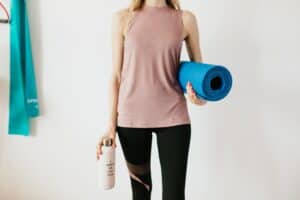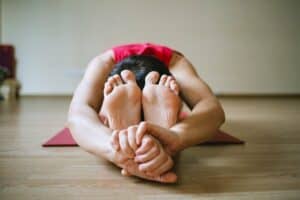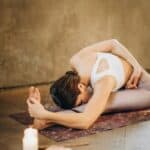Yoga is a relaxing practice meant to calm our minds and bodies. Paschimottanasana is among the most important yoga poses that bears numerous benefits, both mental and physical. Including this asana in your daily practice increases flexibility, helps with back pain, and anxiety.
Yoga is about finding strength in your body in a relaxing way. And it is of utmost importance to remember this rule during paschimottanasana. Although fairly straightforward and known to everybody, this pose is not an easy one. And to relax in it is a great accomplishment that teaches you the value of patience.

Paschimottanasana derives from the word intense stretch and west. This is the basic level 1 asana that can be modified to suit beginners and give experienced practitioners a deeper stretch. As a part of a yoga sequence, it is usually placed at the end after a few preparatory asanas as a forward bend or standing split. This is a challenging pose that is best followed by Savasana.
What Are the Benefits of Paschimottanasana?
Calming Effects
Paschimottanasana helps to calm the brain and your nervous system. Included in a fulfilling sequence, this pose is a natural stress relief means. Mild depression symptoms and anxiety recede as you relax in a forward fold. There is no need for a deep fold my cal your mind and body.
Flexibility
 This seated forward fold stretches back, pelvis, hamstrings, and even calfs. An excellent full-body stretch increases your flexibility overall, opens up your hips, and engages your lower body. It is advantageous for runners to avoid injuries and improve performance on the track.
This seated forward fold stretches back, pelvis, hamstrings, and even calfs. An excellent full-body stretch increases your flexibility overall, opens up your hips, and engages your lower body. It is advantageous for runners to avoid injuries and improve performance on the track.
Which Yoga Is Best For Flexibility?
Pain Relief
Although this asana mainly focuses on the lower back, your upper back and shoulders expand as well. By increasing your back body’s flexibility, you decrease the pull on the muscles around your spine. In a few weeks of regular forward folds, you’ll notice that your back bothers you less and less.
Better Digestion
A deep stretch around the midriff massages the abdominal and pelvic organs, thus improving your digestion. Paschimottanasana can be an instant relief asana for acute digestion issues. If practiced regularly, bend yoga lessens the symptoms of chronic diseases.
Internal Stimulation
As mentioned before, paschimottanasana stimulates the abdominal and pelvic organs. Besides digestion, it touches the ovaries, kidneys, liver, bladder, and uterus, affecting their functions.
 How to Do
How to Do
- Sit on the floor with your legs stretched before you and a straight back, toes towards you.
- Raise straight hands above your head. Keep the core engaged.
- By tilting your hip joints, lean slightly forward. Keep the spine erect and lengthen the tailbone away from the pelvis.
- With every breath, relax and tilt a bit lower and lower. Do not forcefully push your lower back; just lengthen your torso.
- If you can, grasp your toes; if not, rest your hand on shins or ankles.
- Stay in this position for a minute if you are comfortable.
- Slowly, return to the initial position.
Intense Side Stretch Pose (Parsvottanasana)
Tips
Paschimottanasana can be a difficult post to execute and hold, even though it is considered beginner-friendly. Here are a few tips that will help with the proper execution and lower the strain a bit.
- If your hamstrings and back are too tight for this forward bend and you feel uncomfortable in this pose:
-
- put a folded blanket under your buttocks to tilt your spine a bit
- bend your legs in the knees – it’s totally acceptable for beginners
-
- To better understand what exactly needs to be done, imagine lowering your belly to thighs instead of hunching shoulders and putting your head on the legs. It will lengthen your spine and stretch your whole back body.
- Use a yoga strap. If you cannot touch your toes, it’s better to use a strap that gives you better control in keeping the spine straight. Just hook the strap around your feet and take each end in each hand. Your elbows should be unbent.
- No force! In the beginning, you’ll find that this asana is more about sitting straight and tilting for just an inch or two instead of a full fold. If this is your case, work on feeling comfortable in this variation, the fold will come in the future. Do not forget that yoga breathing techniques also play a big role in your practice.
Variations
Expert-Level
If your flexibility goes beyond that and you find the standard variation too easy, go into a deeper stretch. Take a block and put it behind your feet and simply lay your hands beyond the feet. You can also grasp the wrist of one hand with the other around the feet.
Partner Pose
If you practice with a partner, you can do paschimottanasana in turns by helping each other. A supporting partner has to lower on the floor behind the practicing one. As a person holds forward, place your hands on their lower back and put gentle pressure to help extend the spine and tilt the pelvis. Remember not to push!
Rounded Spine
After you reach step 5 in your seated forward bend, some would suggest rounding the spine in that position. The stretch will seem deeper, but the true intention is to rest comfortably in this pose for a couple of minutes.
Seated Forward Bend (Paschimottanasana)
Some yoga practitioners would tell you that this variant is wrong and unnecessary; others will tell you it’s acceptable and relaxing. In the end, the choice is always yours.
Trianga Mukhaikapada Paschimottanasana
 This ose combines three basic asanas, thus the name tianga: paschimottanasana, virasana, and dandasana.
This ose combines three basic asanas, thus the name tianga: paschimottanasana, virasana, and dandasana.
This is a seated forward fold that follows the same guidelines but with one leg bent backward.
In the preparation phase, as you sit on the floor, extend one leg straight and bend the other under and backward. Do not sit on it; instead, make sure that your foot is placed beside your butt, not under it. Release the pose and switch legs.
Ardha Baddha Padma Paschimottanasana
This alternation also has one leg straight and the other bent.
This time, bend your leg as in a lotus pose with your foot placed on the upper thigh or the other leg’s knee. An alteration for beginners is to place a yoga block under the bent leg’s knee for support.